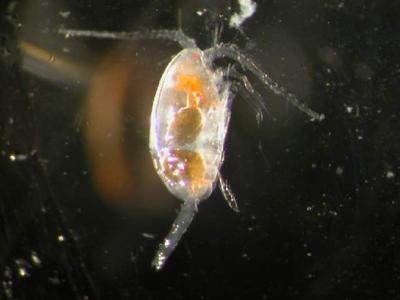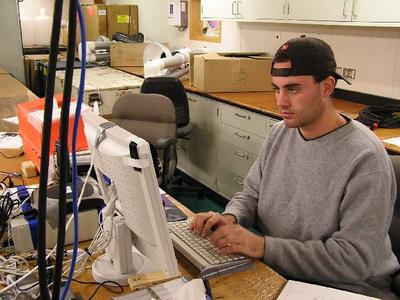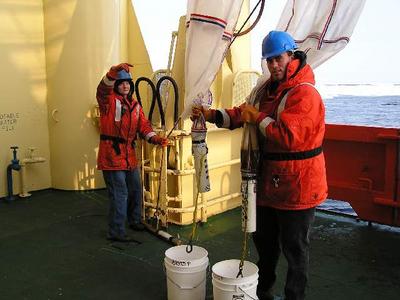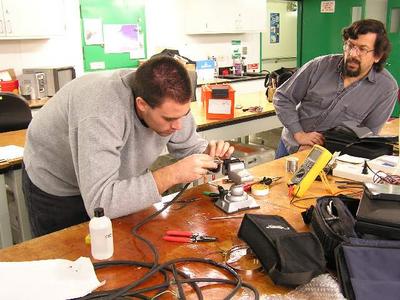7 August, 2003
There's one. Wow! The head of a huge arrow worm- nearly three
centimeters long- comes into the microscope's field of view. Craig
Aumack expertly zooms-in on the business end of this vicious
leviathan of the deep. Thanks to Craig, I get an introduction to
their hunting technique, and in parcticular, close-up views of the
creature's two tusk-like spines that form its mouth.
Plainly put, the arrow worm is the scourge of the copepods. It lies
in wait, but with lightning-quick speed, the arrow worm will seize
its unsuspecting prey with its sharp pinchers after sensing the
ripples generated in the water by a swimming copepod. Craig
speculates that the arrow worm's "jaws," along with other zooplankton
species have inspired numerous creatures and their mouth parts in
such movies as "Alien" and "Tremors." He goes on to provide more
vivid examples that I can't share here, but with interesting
anecdotes like that, it's easy to get caught-up in Craig's enthusiasm
for his work. (See 21 July for more on copepods.)
Craig is one of the talented graduate students on board from the
Marine Botany Lab at the University of Texas Marine Science
Institute. Craig possesses a keen intelligence with the ability to
grasp concepts quickly, making him a pleasure to work with for
everyone on board. As such, he has pitched right in and helps out
with just about every thing there is to do. He directs CTD casts,
collects various water samples, and helps deploy the Bongo Net. Early
on Craig showed some interest in the Lowered Acoustic Doppler Current
Profiler gadget (my term), so Electronics Technician Rob Palomares
provided the instruction, and Craig has been taking turns with Rob in
hooking-up and down-loading the LADCP data ever since.
Interestingly, this is not Craig's first time to the Arctic; in fact,
he is just finishing-up his Master's thesis which involved modeling
the productivity of kelp beds in the Beaufort Sea north of Prudhoe
Bay, Alaska. I thought it was something just working up here on the
Palmer, but Craig's field research for his thesis included SCUBA
diving in these icy waters!
And Craig is conducting some equally fascinating research during our
cruise in addition to his duties described above. In most of his own
words:
I am investigating the spatial (location) and temporal (time) changes
in the food web by using stable isotopes of carbon and nitrogen. All
organisms possess Carbon-12 and Nitrogen-14 as well different forms
of carbon and nitrogen, called isotopes, although in much smaller
quantities. In this study, I will measure the ratios of Carbon 12 to
its isotope Carbon-13, and Nitrogen-14 to its isotope Nitrogen-15.
These ratios are unique in each kind of primary producer, so they can
be used as a "molecular fingerprint" to identify where the carbon and
nitrogen came from. This works because- literally- you are what you
eat! A cow's diet of grass, for example, gives it a parcticular
Carbon-13/12 ratio, while a fish feeding on phytoplankton will have
its own unique C-13/12 ratio. Using this method we can determine the
ultimate carbon source(s) of each community of organisms.
I do this by collecting Parcticulate Organic Matter Samples and
various zooplankton species for isotopic analysis back in the Botany
Lab at the University of Texas. These POM samples are important
because they contain the phytoplankton that the zooplanktons are
likely feeding on. To process the sample, I must first dry the POM
sample in an oven until all the water is gone. Then I grind it into a
fine powder using a mortar and pestle. This powder is placed in an
elemental analyzer which combusts the material into its basic
constituents. These burnt remains are then transferred to a mass
spectrometer that measures the various amounts of each isotope from
which the appropriate ratios can be determined.
From his earlier work, Craig goes on to explain: So far, in the
Arctic basin, we have observed both spatial and temporal changes in
the stable isotope values of several organisms. Certain species of
copepods have decreasing isotopic compositions in the eastern portion
of the basin while there is a noticeable change in the ratios of
several populations of copepods between spring and summer. These
observations suggest that the copepods are not only changing their
diet seasonally, but copepods further to the west. It is our
hypothesis that the seasonal and spatial changes of these isotopic
signals can be attributed to ice algae entering the food web during
the spring months. Ice algae have higher C-13/12 and N-15/14 ratios
than most phytoplankton. When ice melts in the spring months the
algae falls into the water column, and thus, becomes available for
grazing by the larger zooplanktons. This may explain the higher
isotopic ratios that we are measuring during the spring.
Indeed, you can be sure this energetic marine botanist will collect
and analyze every sample until he tracks down the carbon and nitrogen
sources, slowly but surely, POM by POM, plankton by plankton.

Copepod, or put another way, arrow worm food.

Arrow worm head: Note the two pinkish-orange spines that form part of the predator's "jaws."

Craig counting plankton under the Palmer's microscope.

Craig Aumack down-loading the LADCP data after a cast of the rosette.

Craig and marine technician Jenny White recovering the Bongo Net.

Craig repairing cable with electronics technician Rob Palomares's help.
Contact the TEA in the field at
.
If you cannot connect through your browser, copy the
TEA's e-mail address in the "To:" line of
your favorite e-mail package.
|
